- Top Employee Onboarding Software
- Why Use Employee Onboarding Software?
- Key Features of Effective Onboarding Software
- How To Choose The Right Onboarding Software?
- Which is the Best Onboarding Software?
- Frequently Asked Questions (FAQs)
- What Is Upskill And Reskill?
- Difference Between Reskilling And Upskilling
- Upskilling for Workplace Advancement
- Reskilling for Career Transformation
- Crafting Successful Upskill and Reskill Strategies
- Upskill And Reskill Strategizing: Things to Keep in Mind
- Measuring the Impact of Skill Development Initiatives
- Frequently Asked Questions
- What’s a Skill Gap?
- Employee Skill Gap Analysis: Why Do We Need It?
- How To Conduct Employee Skill Gap Analysis?
- Addressing Skill Gaps Through Training and Hiring
- Utilizing Skills Gap Analysis for Strategic Planning
- Leveraging Employee Skill Gap Analysis: Things To Keep In Mind
- Frequently Asked Questions
- Transformative Role of AI in Talent Acquisition
- Impact of AI on Business Recruiting
- Overcoming Challenges in AI-Driven Talent Acquisition
- Starting with AI in Talent Acquisition
- Future Landscape of AI in Talent Acquisition
- Frequently Asked Questions
- HR In The Hot Seat - Challenges With Evolving Workforce
- Mastering Effective HR Management: Tips For Overcoming Challenges
- Summing Up
- The Future of HR: Key Trends for 2024
- Skill-Based Hiring
- Prioritizing Employee Experience, Engagement & Well-being
- AI-Empowered Workforce Evolution and Its Impact
- Taking Diversity, Equity, and Inclusion Beyond Mandates
- Hybrid and Remote Work
- Embracing the Gig Economy and Blended Workforce
- Transparent HR Practices
- Climate Change Adaptation in HR Practices
- Leveraging HR Analytics for Data-Driven Decisions
- Continuous Learning & Development to Improve Productivity
- The Office Buzz in 2024
- Bottom Line - HR Operating Model Needs A Shift
- Importance and Impact of Recognizing Employee Birthdays
- Professional Birthday Wishes for Employees (All Experience Levels)
- Personalized Birthday Wishes for Employees in Different Roles
- Fun Birthday Wishes for Employees (with Templates)
- Birthday Wishes for Remote Employees
- Heartfelt Birthday Wishes for Employees
- Belated Birthday Wishes for Employees
- Simple & Sweet Birthday Wishes for Employees
- Celebrating Employee Birthdays: Ideas and Traditions
- Tips and Ideas for Sending Birthday Wishes to Employees
- Closing Thoughts
- Frequently Asked Questions
- What Is An Employee Referral?
- Benefits of Implementing Employee Referral Programs
- Setting Up an Effective Employee Referral Program
- Employee Referral Email
- Employee Referral Scheme
- Overcoming Challenges of Employee Referrals
- Companies with Best Employee Referral Programs
- Employee Referral Programs: Best Practices
- Closing Thoughts
- Frequently Asked Questions (FAQs)
- Importance of Team Building Activities
- Types of Team Building Activities
- Outdoor Team Building Activities for Employees
- Indoor Team Building Activities for Employees
- Easy Team Building Activities for Remote Employees
- Team Building Activities For New Employees (Icebreakers)
- Fun Team Building Activities for Different Goals
- To Boost Communication and Collaboration
- To Reduce Stress Levels and Promote Well-being
- Aligning Team Purpose and Values with Strategic Activities
- Final Remarks
- Frequently Asked Questions
- Importance of Employee Appreciation Quotes
- Work Appreciation Quotes for Employees
- Employee Appreciation Quotes for Hard Work Recognition
- Employee Appreciation Quotes for Teamwork and Collaboration
- Appreciation Quotes for Celebrating Employee Anniversaries and Milestones
- Employee Appreciation Quotes for Strong Work Ethics
- Employee Appreciation Quotes for Project & Goal Completion
- Employee Appreciation Quotes for Quality of Work
- Employee Appreciation Quotes for Creativity and Innovation
- Appreciation Quotes for Managers
- Peer-to-Peer Employee Appreciation Quotes
- Appreciation Quotes for Employees Leaving the Company
- Employee Appreciation Quotes for Thoughtful Gestures
- Funny Employee Appreciation Quotes
- Short Employee Appreciation Quotes
- Employee Appreciation Quotes for Different Roles
- Employee Appreciation Quotes for Senior Leadership
- Creative Ways to Use Employee Appreciation Quotes
- Summary
- Frequently Asked Questions (FAQs)
- What is Employee Satisfaction?
- Importance of Employee Satisfaction
- Objectives of Employee Satisfaction
- Employee Satisfaction vs. Employee Engagement
- Key Reasons for Employee Dissatisfaction
- Strategies for Improving Employee Satisfaction
- Ways to Measure Employee Satisfaction
- Best Practices for High Employee Satisfaction
- Final Remarks
- Frequently Asked Questions (FAQs)
- How to Craft Effective Employee Appraisal Comments
- Key Areas to Focus in Performance Review
- Comments On Hard Work & Dedication
- Assessing Interpersonal Skills
- Evaluating the Ability to Collaborate & Work in Teams
- Gauging Punctuality
- Commenting on Communication Style
- Reviewing Time Management and Productivity
- Leadership in Performance Appraisals
- Assessing Creativity & Innovation
- Evaluating Problem-Solving Abilities
- Recognizing Flexibility and Dependability in Reviews
- Employee Appraisal Comments for Different Roles
- Summary
- Frequently Asked Questions (FAQs)
- Employee Grievance Meaning
- Importance of Employee Grievance Process
- Types of Workplace Grievances
- Reasons for Employee Grievances
- Employee Grievance Procedure
- Steps in the Employee Grievance Handling Process
- Employee Grievance Form Example
- Final Remarks
- Frequently Asked Questions (FAQs)
- What is Company Culture?
- Importance of Company Culture
- Types of Company Culture
- Factors Contributing to Organizational Culture
- Assessing & Developing Corporate Culture
- Company Culture - It’s not just Perks or Feels
- Good Company Culture Examples
- Developing Company Culture: Best Practices
- Closing Thoughts
- Frequently Asked Questions (FAQs)
- What is Employee Empowerment?
- Benefits of Empowering Employees
- Employee Empowerment vs. Micromanagement
- Strategies for Effective Employee Empowerment
- Role of Managers in Fostering Empowerment
- Organizational Structure Supporting Empowerment
- Overcoming Barriers to Employee Empowerment
- Frequently Asked Questions (FAQs)
- What is Employer Branding?
- Importance of Employer Branding Strategy
- How to Build an Employer Branding Strategy?
- Strategies for Building a Strong Employer Brand
- How to Measure and Boost Your Employer Branding Success?
- Examples of Strong Employer Brand Strategy
- Best Practices for an Effective Employer Branding Strategy
- Closing Thoughts
- Frequently Asked Questions (FAQs)
- What are Employee Wellness Programs?
- Importance of Employee Wellness Programs
- Examples of Employee Wellness Programs
- Real-Life Examples of Corporate Wellness Programs
- Strategies for Encouraging Participation
- Supporting Diverse Employee Needs
- Creating Comprehensive Wellness Programs
- Measuring the Impact on Business and Employees
- Closing Thoughts
- Frequently Asked Questions (FAQs)
- What is Talent Management?
- Developing a Winning Talent Management Strategy
- Models and Frameworks
- Tips for Framing Effective Talent Management Strategy
- Looking Ahead: Recent Trends in Talent Management
- Frequently Asked Questions
- Role of AI in HR: Addressing Common Challenges
- Artificial Intelligence in HR Processes
- AI Tools for HR Functions
- How to Adopt AI in HR?
- Addressing Challenges of AI in HR
- Ethical and Responsible AI Use
- The Future of AI in HR
- Closing Thoughts
- Frequently Asked Questions
- What is Performance Management?
- Elements of Effective Performance Management
- Performance Management Cycle
- Differentiating Performance Management
- Benefits of Performance Management With Examples
- Challenges faced in Performance Management and their Solutions
- Future Trends in Performance Management
- Frequently Asked Questions
- Changing Role of HRM
- Changing Role Of HR Manager
- Technology and the Changing Role of HRM
- The Rise of AI and Machine Learning in HR
- Mobile Technology's Impact on HR Practices
- The Significance of People Analytics in HR
- Navigating the Future of HR Technology
- Final Remarks
- Frequently Asked Questions
- Compensation Management Meaning
- Compensation Types
- Breaking Down The Compensation Management Process
- HR Software for Compensation Management
- Current Trends in Compensation Management
- Frequently Asked Questions
- Defining Flexible Work Arrangements
- Flexible Working: Advantages for Businesses
- Challenges of Flexible Work Arrangements
- Crafting Flexible Working Practices
- Types Of Flexible Work Arrangements
- Comparing Flexible Work Arrangements
- Real-Life Examples of Flexible Work Arrangements
- Final Remarks
- Frequently Asked Questions
- Conflict Resolution Meaning
- Conflict Origins
- Tried & Tested Conflict Resolution Strategies
- Methods of Conflict Management at Workplaces
- Conflict Resolution Strategies: Top Management Tips
- Summary
- Frequently Asked Questions
- Career Development Meaning
- Career Development Plan for Employees
- Career Development in HRM: Growth Ideas For Employees
- Issues in Career Development and Their Solutions
- Closing Thoughts
- Frequently Asked Questions
- Understanding Compensation
- Exploring Benefits
- Difference between Compensation and Benefits
- Compensation & Benefits Structure
- Final Remarks
- Frequently Asked Questions
- Defining Recruitment in HR Practices
- Exploring Talent Acquisition in HR
- Understanding Talent Acquisition vs Recruitment
- When to Recruit or Acquire Talent
- Talent Acquisition vs Recruitment: Responsibilities
- From Recruitment To Talent Acquisition
- Closing Thoughts
- Frequently Asked Questions
- Work Culture Meaning
- Types of Work Cultures
- Components of Culture
- Best Work Culture Examples Set By Top Companies
- Creating a Positive Work Culture
- Closing Thoughts
- Frequently Asked Questions
- Defining Learning vs Development
- Importance of Learning and Development
- L&D Activities for Employees
- Choosing the Right L&D Activities
- Crafting an Effective L&D Strategies
- Aligning L&D Strategy with Business Goals
- Designing Engaging Learning Journeys
- Learning and Development Process: KPIs
- ROI in Learning and Development
- Emerging Trends in L&D
- Closing Thoughts
- Frequently Asked Questions
- What Is Leadership Development?
- Key Skills for Leaders
- How To Develop Leadership Skills in Organizations?
- What Is A Leadership Development Program?
- How To Develop A Leadership Development Program?
- Example of A Leadership Development Plan
- Benefits of Leadership Development Training
- Frequently Asked Questions
- Defining Diversity Training
- Importance of Diversity Training
- What are the Types of Diversity?
- Types of Diversity Training Methods
- Diversity Training Activities
- Choosing A Diversity Training Program
- How to Implement Diversity Initiatives
- Best Diversity Training Programs (Real-Life Examples)
- Improving the Effectiveness of Diversity Training
- Tracking and Evaluating the Results of DE&I Training Efforts
- Essential Elements for Successful Diversity Training
- Closing Thoughts
- Frequently Asked Questions
- Defining Occupational Health & Safety
- Evolution of Workplace Health and Safety
- Identifying Common Workplace Hazards
- Global Impact on Occupational Health & Safety
- Managing Employee Health and Safety Risks
- Occupational Health and Safety Problems
- Future of Occupational Health and Safety
- Frequently Asked Questions
- Employee Orientation Defined
- Employee Onboarding Explained
- Orientation and Onboarding: Understanding the Difference
- Importance of Orientation and Onboarding
- Crafting Comprehensive Integration Strategies
- Quick Tips for Orientation and Onboarding
- Frequently Asked Questions
- What is HR Metrics?
- Importance of HR Metrics
- HR Metrics Examples in Recruitment
- HR Metrics Examples in Employee Retention
- HR Metrics Examples in Revenue
- Other Common HR Metrics
- Soft HR Metrics Example
- HR Metrics Formula
- Utilizing HR Metrics Effectively
- Future of HR Metrics
- Summary
- Frequently Asked Questions
- Defining Decision Making Process
- Key Concepts In Decision Making
- Decision Making & Problem Solving
- Tips For Improving Decision Making Skills
- Selected Practice Questions & Answers
- Conclusion
- Frequently Asked Questions (FAQs)
- A case(s) of miscommunication
- The devil is in the (resume) details
- One for the complaints!
- What is an Exit Interview?
- Benefits of Exit Interviews to an Organization
- How to Conduct Exit Interviews?
- Exit Interview: Sample Questions to Ask
- Overcoming Challenges of Exit Interviews
- Exit Interviews: Best Practices
- Closing Thoughts
- Frequently Asked Questions
- Technology in the Workplace
- Benefits of Tech Integration
- Technology in the Workplace: Key Functions
- How Technology Normalized Remote Work
- Workplace Technology: Top Tools and Software
- Steps for Effective Technology Implementation
- Overcoming Tech Implementation Challenges
- Ethical Considerations in Tech Use
- Keeping Pace with Tech Trends
- Closing Thoughts
- Frequently Asked Questions
- What is Ethical Leadership?
- Principles of Ethical Leadership
- Difference between Ethics and Integrity
- Importance of Ethical Leadership
- Ethical Leadership in Practice
- Overcoming Challenges
- Frequently Asked Questions
- Embracing Change Management
- Mastering People Analytics
- Enhancing Stakeholder Relationships
- Navigating Diversity, Equity & Inclusion
- Upholding Ethics and Data Privacy
- Developing Critical Thinking
- Advancing Negotiation Techniques
- Fostering Inter-departmental Collaboration
- Building Resilience in HR
- Frequently Asked Questions
- What is Mental Health?
- Benefits of a Mentally Healthy Workforce
- Prioritising Mental Health: Creating a Culture of Support
- Final Remarks
- Frequently Asked Questions
- Gen Z vs Millennials - What is the difference?
- Retain and Engage Gen Z Employees: Need and Strategies
- Strategies to Retain and Engage Gen Z Employees
- Rethinking Requirements
- Final Remarks
- Frequently Asked Questions
- Understanding Millennial Leadership Needs
- Key Leadership Skills for Millennials
- How To Develop Millennial Into Leaders
- Additional Strategies to Develop Leaders
- Learning Preferences of Millennials
- Benefits of Investing in Millennial Leaders
- Closing Thoughts
- Frequently Asked Questions
- Understanding Fluff
- Examples of Interview Fluff
- Identifying Interview Fluff
- Addressing Interview Fluff
- Seeing Through the Fluff
- Frequently Asked Questions
- What is the Gender Pay Gap?
- Is the Gender Pay Gap Real?
- Factors Affecting the Gender Pay Gap
- How Age Impacts Women’s Earnings
- The ‘Motherhood Penalty’
- Education's Role in Wage Differences
- Racial and Ethnic Disparities in Pay
- Closing the Gender Gap
- Frequently Asked Questions
- Top Weirdest Late-To-The-Office Excuses
- The Fine Art of Balancing Wit and Wisdom in HR
- Understanding Social Media Recruiting
- Crafting Your Social Media Recruitment Strategy
- Implementing Your Strategy Effectively
- Popular Platforms for Recruitment
- Navigating the Downsides of Social Media Recruiting
- Measuring Success and Adjusting Strategy
- Summary
- Frequently Asked Questions
- Who Is A High Potential (HIPO) Employee?
- Characteristics of A High Potential (HIPO) Employee
- High Potential Employee Identification
- Grooming High Potential Employees
- Why High Potential Employees Leave
- How Do You Retain High Potential Employees?
- High Potential Employee Development: Best Practices
- Closing Thoughts
- Frequently Asked Questions
- What is Digital Fluency?
- Why Digital Fluency Matters?
- Difference between Digital Literacy and Digital Fluency
- Key Components of Digital Fluency
- Achieving Digital Fluency
- Overcoming Challenges
- Future of Workforce Digital Fluency
- Frequently Asked Questions
- What is Loud Quitting?
- Pros and Cons of Loud Quitting
- Reasons Behind the Trend
- Analyzing the Impact
- How HR Can Navigate the Loud Quitting Uproar
- Preventive Strategies
- Closing Thoughts
- Frequently Asked Questions
- Defining Emotional Intelligence in HR
- Why Emotional Intelligence Matters for HR Leaders
- How To Build Emotional Intelligence in HR
- Integrating EQ into HR Practices
- Impact of EQ on Company Culture
- Emotional Intelligence in HR: Major Challenges
- Final Remarks
- Frequently Asked Questions
- Understanding Internal Job Posting
- Internal Job Posting: Pros and Cons
- The Internal Job Posting Process
- Writing Effective Ads for Internal Job Posting
- Strategies for Success of Internal Job Posting
- Summary
- Frequently Asked Questions
- Understanding Workplace Bias
- Common Types of Bias in HR
- Closing Thoughts
- Frequently Asked Questions
- What is a Dry Promotion?
- Dry Promotion: Pros and Cons for Companies
- Impact of Dry Promotion on Employee Retention
- Preventing Talent Loss After Dry Promotions
- Closing Thoughts
- Frequently Asked Questions
- What Is A Stay Interview?
- Importance Of Stay Interviews
- Benefits And Challenges Of Stay Interviews
- Planning And Conducting Stay Interviews
- Stay Interviews: 20 Sample Questions To Ask
- Best Practices For Effective Stay Interviews
- Summary
- Frequently Asked Questions
- Who Is A Boomerang Employee?
- Reasons For Returning
- Benefits Of Hiring Boomerang Employees
- Challenges Of Rehiring
- Interviewing Boomerang Candidates: Sample Questions
- Enhancing The Hiring Process
- Making Informed Decisions
- Final Remarks
- Frequently Asked Questions
- Talent Pipeline Meaning
- Significance of Talent Pipelines
- Advantages of a Talent Pipeline
- Building a Talent Pipeline
- Maintaining a Talent Pipeline
- Attracting Top Talent
- Implementing the Strategy
- Frequently Asked Questions
- What is Micromanagement?
- Recognizing Micromanagement
- Leadership versus Micromanagement
- Keeping Micromanagement in Check
- Beyond Micromanagement
- Summing Up
- Frequently Asked Questions
- Recognizing Signs Of A Bad Hire
- Understanding The Impact On Teams
- Dealing With A Bad Hire
- Preventing Future Bad Hires
- Closing Thoughts
- Frequently Asked Questions
- Defining Neurodiversity
- Importance of Neurodiversity in the Workplace
- Moving Towards Inclusive Environments
- Final Remarks
- Frequently Asked Questions
- Understanding the Generation Gap
- Multigenerational Workforce: Debunking Stereotypes
- Strategies for Bridging the Gap
- Benefits of a Multigenerational Workforce
- Final Remarks
- Frequently Asked Questions
- Defining Productivity Theatre: All Show, No Go
- 5 Key Drivers of Fake Productivity
- Solutions to Combat Productivity Theatre
- Summary
- Frequently Asked Questions
- Defining Grumpy Staying
- Why do Grumpy Stayers not Leave?
- Recognizing the Signs
- Exploring the Causes
- Understanding the Impact
- Addressing the Issue
- Taking Action: Addressing Grumpiness with Empathy
- After the Conversation
- When Grumpy Staying Continues
- Closing Thoughts
- Frequently Asked Questions
- The Rationale Behind Office Peacocking
- Impact on Company Culture
- Impact on Employees
- Case Studies: Examples of Office Peacocking
- The Downside: Potential Pitfalls of Office Peacocking
- Practical Tips for Implementing Office Peacocking
- Frequently Asked Questions
- 13 Common Mistakes Young Managers Make
- Strategies To Avoid Mistakes (Individual Growth)
- How Young Managers Can Boost Teamwork
- Learning From Errors
- Summary
- Frequently Asked Questions
- Understanding Great Regret - What causes the shift shock?
- Impact of Great Regret
- How can HR help make the situation better?
- Closing Thoughts
- Frequently Asked Questions
- Understanding the HR Budget
- Key Components of an HR Budget
- Preparing an HR Budget Step-by-Step
- Importance of HR Budgeting in Management
- Final Remarks
- Frequently Asked Questions
- What are Pre-Employment Assessments?
- Importance of Pre-Employment Testing
- Types of Pre-Employment Assessments
- 15 Tips for Creating Effective Pre-Employment Assessments
- Closing Thoughts
- Frequently Asked Questions
- Exploring the Productivity Paradox
- Understanding the Impact of Solow Paradox
- Productivity Paradox: Why it Matters for Recruiters & HRs
- Identifying Causes and Challenges
- Strategies for Enhancing Productivity
- AI & the Modern-Day Productivity Paradox
- Beyond Technology: Building a Productive Workforce
- Summary
- Frequently Asked Questions
- Understanding the Great Reshuffle 2.0
- Preparing Leaders for the Change
- HR’s Role in Handling Great Reshuffling 2.0
- The Way Ahead
- Frequently Asked Questions
- Definition Of Managerial Grid
- Managerial Grid Theory Explained
- Application Of Managerial Grid
- Criticisms And Limitations
- Evolution And Contemporary Perspectives
- Integrating Managerial Grid With Other Models
- Practical Steps For Implementing Managerial Grid
- Conclusion
- Frequently Asked Questions
- Understanding Skills Taxonomy
- Why do we Need Skills Taxonomy?
- Benefits of Skills Taxonomy
- Components of Skills Taxonomy
- Building a Skills Taxonomy: A Step-by-Step Guide
- Skill Taxonomies vs Intelligence Tools
- Closing Thoughts
- Frequently Asked Questions
- Definition Of Team Building
- Stages Of Team Development
- Top 10 Strategies For Effective Team Building
- Team Building Activities
- Best Practices For Effective Team Building
- Setting Team Building Objectives
- Challenges In Team Building
- Conclusion
- Frequently Asked Questions (FAQs)
- Defining Job Shadowing
- Unpacking the Benefits
- Setting Up the Experience
- Job Shadowing vs Internship
- Dos and Don'ts for HR Professionals
- Closing Thoughts
- Frequently Asked Questions
- Employee Journey Mapping: Meaning & Importance
- Stages of the Employee Journey
- Steps for Effective Mapping
- Employee Journey Map: Where does it begin?
- Employee Journey Map: Template
- Best Practices & Tips
- Summary
- Frequently Asked Questions
- Why are Performance Appraisals needed?
- Evolution of Performance Management
- Modern Performance Practices
- Benefits of Modern Performance Appraisals
- The Future
- Frequently Asked Questions
- Is Experience the Sole Indicator of Success?
- Why Hire Inexperienced Talent?: Key Advantages
- Skills to Look For in Inexperienced Talent
- Challenges and Considerations in Hiring Inexperienced Talent
- Final Remarks
- Frequently Asked Questions
- What is a Company Retreat?
- Company Retreat Ideas: Team-Building & Exploration
- Relaxation and Celebration
- Planning Your Retreat: Things to Keep in Mind
- Closing Thoughts
- Frequently Asked Questions
- Understanding HR Forecasting
- HR Forecasting Key Concepts
- Steps for Implementing HR Forecasting
- Common HR Forecasting Methods
- Closing Thoughts
- Frequently Asked Questions
- What is ESG?
- HR and ESG - Why Care?
- ESG in HR Strategy
- Challenges for HR
- Future of ESG in HR
- Frequently Asked Questions
- Defining the Great Betrayal
- Reasons for Its Spread
- Impact on Workers
- Impact on Corporations
- Rebuilding Trust & Valuing Employees
- Closing Thoughts
- Frequently Asked Questions
- Importance of Clear Expectations
- Setting Expectations Early
- Communicating Expectations Effectively
- Differentiating Expectations
- Reviewing and Adjusting Expectations
- Summing Up
- Frequently Asked Questions
- Understanding KRA Frameworks And Models
- KRAs vs KPAs and KPIs
- Monitoring and Tracking KRAs
- KRAs in Various Roles
- Impact of KRA Frameworks and Models on Organizational Success
- Frequently Asked Questions
- Where: The Place of Work
- When: The Time of Work
- How Much Work: Alternate Employment Models
- Who Does the Work: Intelligence
- Designing Organizations with the Four Dimensions of Work
- Summing Up
- Simplifying Processes: The Foundation of Efficiency
- Reducing Unnecessary Meetings: Reclaiming Valuable Time
- Building Strong Accountabilities: Ensuring Responsibility
- Role of HR in Addressing Inefficiencies
- Continuous Improvement: A Commitment to Excellence
- Leadership's Role in Driving Efficiency
- Conclusion: A Holistic Approach to Efficiency
- Understanding Financial Freedom
- Benefits of Empowering Employees Financially
- Empowering Employees Through Financial Literacy
- Financial Topics That Need Attention Based On Career Stage
- Summing Up
- Frequently Asked Questions
- Defining Employee Voice
- Benefits of Amplifying Employee Voice
- Strategies and Tools
- Encouraging Participation
- Closing Thoughts
- Frequently Asked Questions
- Appraisal Blues: Signs of Unhappy Employees
- Addressing Unhappiness Post-Appraisal
- Non-Monetary Solutions for Dissatisfied Employees
- Summing Up
- Frequently Asked Questions
- Women in the Middle Eastern Workforce
- Importance of DEIB
- Role of HR in Building Inclusive Workplaces for Women
- Measuring Inclusion Progress: Key Metrics
- Closing Thoughts
- Frequently Asked Questions
- Preparing for the Conversation
- Conducting the Conversation
- Best Practices for the Talk
- After the Conversation
- Helping Employees Grow
- Frequently Asked Questions
- Understanding HR Exhaustion
- Factors Leading To HR burnout
- Impact Of HR Burnout
- Strategies To Prevent And Manage HR Burnout
- Role Of Technology In Preventing Burnout
- Celebrating HR Successes
- Summary
- Frequently Asked Questions
- Common Mistakes When Hiring Young Talent
- Building Connections with Candidates
- Summary
- Frequently Asked Questions
- Walking a mile in the employee’s shoes
- Conducting Humane Layoffs
- Remote Layoffs Management
- Supporting Laid-off Workers
- Managing the Aftermath
- Wrapping Up
- Frequently Asked Questions
- Importance of Shortening Time-to-Hire
- Shortening Hiring Time: Pre-Application Stage
- Reducing Hiring Time: Application Stage
- Hacks to Shorten Hiring Time: Interview Stage
- Reducing Hiring Time: Offer Stage
- 5 Other Important Hacks & Strategies
- Final Remarks
- Frequently Asked Questions
Learning And Development: Definition, Importance & Latest Strategies
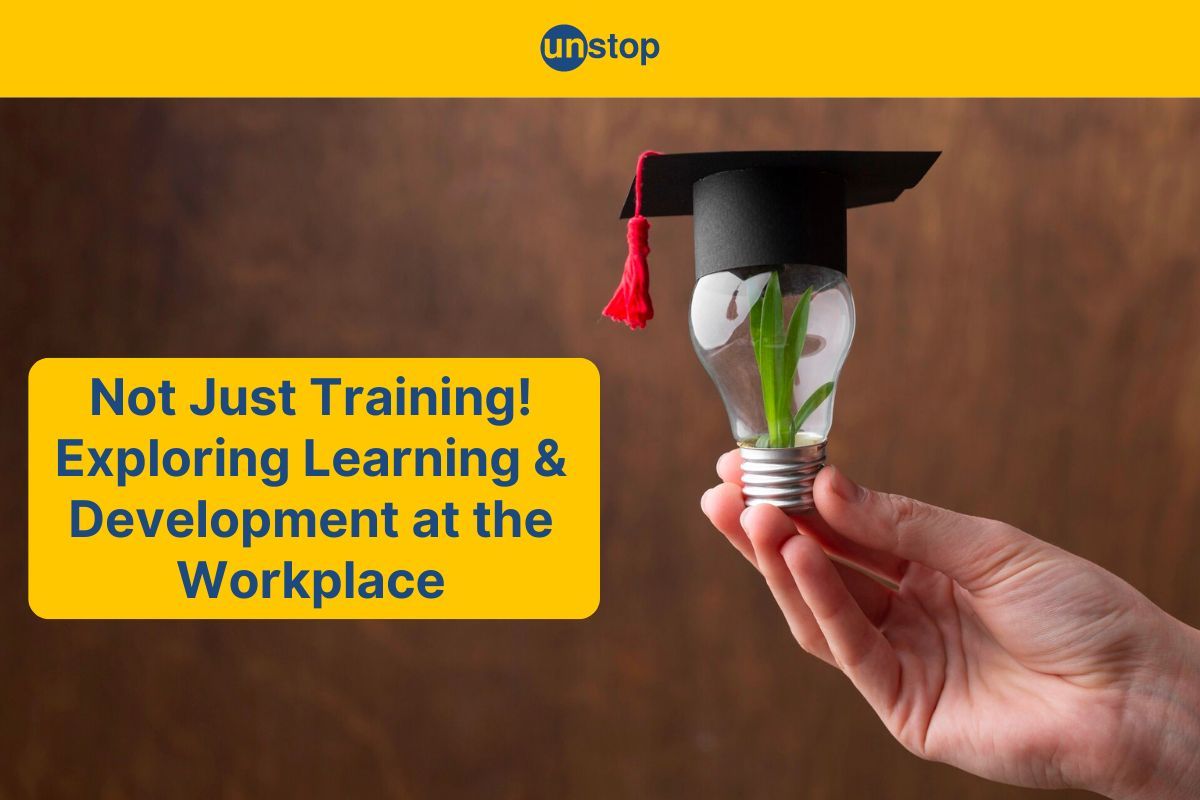
There's a strong correlation between investing in learning and development and positive business outcomes, including increased productivity, employee engagement, and potentially higher profit margins. HBR is one of the many to report how developing employees' strengths boosts profit and engagement.
The impact of fostering growth within your organization goes far beyond just upskilling employees. It cultivates innovation, boosts morale, and drives success. In today's fast-paced world, continuous learning is not just a nice to have; it's a necessity for staying competitive and relevant.
Embracing a culture of learning and development isn't just about ticking boxes—it's about unlocking the full potential of your team members and empowering them to thrive. By prioritizing growth opportunities, you're not only investing in your employees but also securing the future success of your business.
Let’s delve into the transformative power of learning and development initiatives at the workplace.
Defining Learning vs Development
Learning
Learning involves acquiring knowledge and skills through various methods such as studying, training, or practicing. It focuses on absorbing information to understand concepts better.
Learning is a continuous process that individuals engage in throughout their lives. It allows people to expand their understanding of different subjects and areas of interest.
Individuals learn by exploring new ideas, concepts, and experiences. This process enables them to gain new insights into various topics and enhances their problem-solving abilities.
Development
Development revolves around applying and enhancing the skills acquired through learning. It involves the growth and progression of individuals in both personal and professional aspects.
Development emphasizes the practical application of knowledge and skills in real-life situations. It enables individuals to evolve and improve their capabilities and performance levels.
Relationship between development and learning
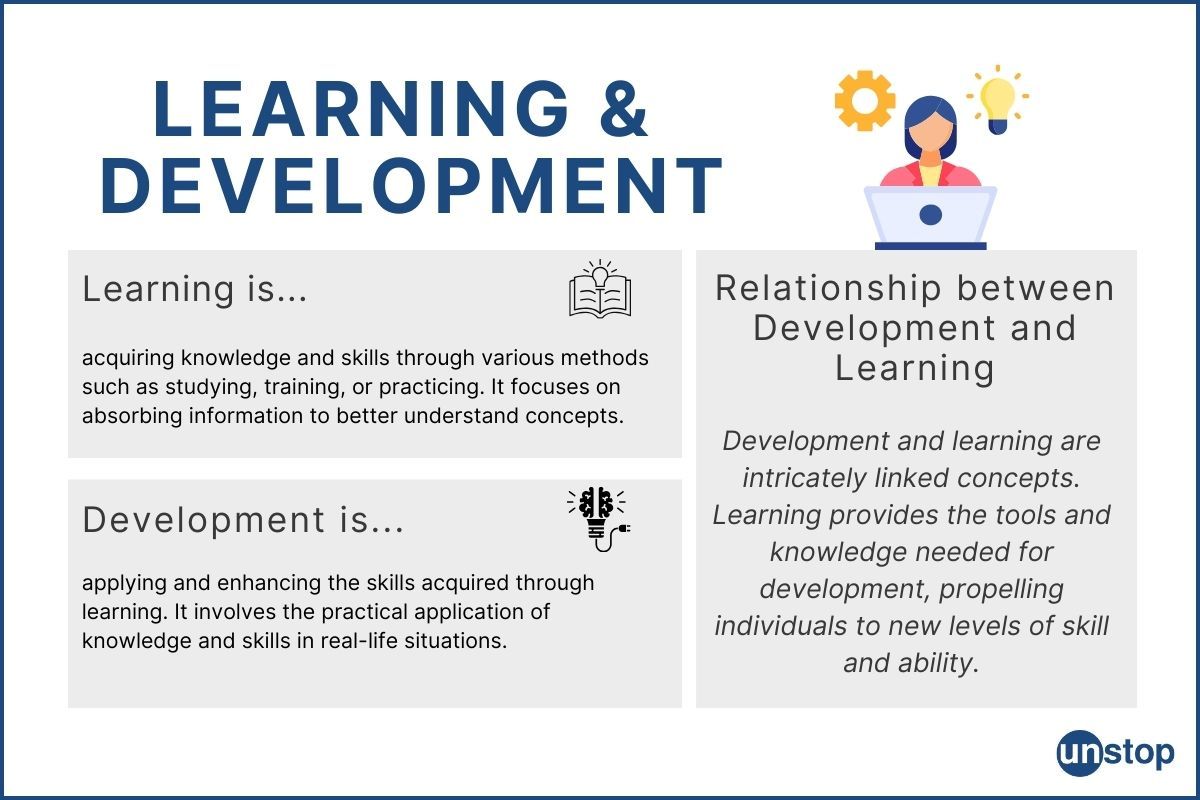
While learning focuses on acquiring new information, development centers around utilizing that knowledge for personal and professional advancement.
Learning and development are closely intertwined concepts that work hand in hand to support personal and professional growth.
Learning involves the acquisition of new knowledge and skills, while development focuses on applying that knowledge to enhance one's capabilities and progress. In essence, learning provides the foundation, while development builds upon it to drive continuous improvement and advancement.
Importance of Learning and Development
Enhancing Skills
Learning and development (L&D) play a crucial role in enhancing employee skills. By providing continuous training and upskilling opportunities, employees can acquire new competencies.
Investing in L&D allows individuals to stay relevant in their roles and adapt to changing industry trends. This, in turn, boosts their performance and productivity at work. As a result, employees feel more confident in their abilities, leading to increased job satisfaction.
Career Progression
L&D is instrumental in career progression. Through structured learning programs and skill development initiatives, employees can advance their careers. This not only benefits the individual but also contributes to the overall success of the organization.
By acquiring new skills and knowledge through L&D, employees become more versatile and capable of taking on challenging roles. This opens up opportunities for career advancement within the company, allowing individuals to climb the corporate ladder.
Employee Retention
Investing in learning and development programs can significantly impact employee retention rates. Employees who receive continuous training are more likely to stay with an organization that prioritizes their professional development.
When organizations prioritize the growth and development of their workforce, employees feel valued and supported. This sense of investment fosters loyalty and commitment among staff members. As a result, companies experience lower turnover rates and higher employee retention, leading to a stable and motivated workforce.
L&D Activities for Employees
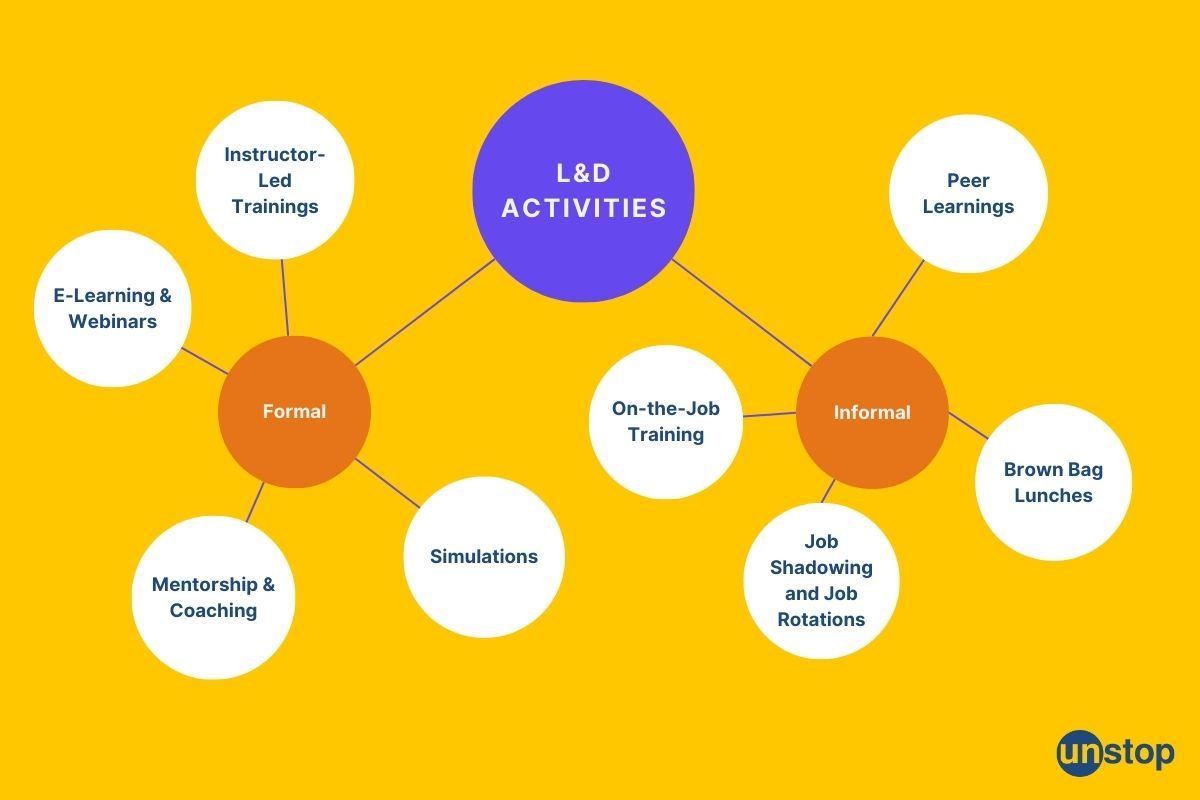
Learning and development activities for employees encompass a wide range of programs designed to equip employees with the skills and knowledge required to perform their jobs effectively.
Here's a breakdown of various L&D activities categorized by their approach:
Formal Learning
- Instructor-Led Training (ILT) or Workshops: Classroom-based sessions with a trainer delivering lectures, demonstrations, and facilitating discussions. Workshops provide hands-on experiences that deepen understanding and promote practical application of knowledge. Suitable for introducing new skills or processes.
- E-Learning Modules: Online courses with interactive content, videos, quizzes, and assessments. Offer flexibility and self-paced learning.
- Webinars and Live Sessions: Interactive online sessions with industry experts or internal specialists on specific topics.
- Simulations: Simulations replicate real-world scenarios, providing a safe environment for learners to practice decision-making and problem-solving skills. This immersive learning approach enhances critical thinking and prepares individuals for challenging situations.
- Mentorship Programs: Pairing experienced employees with less experienced ones for guidance, career development, and knowledge transfer.
- Coaching: Personalized guidance from experts to enhance specific skills or overcome challenges. Coaches provide support, encouragement, and actionable strategies tailored to individual needs, maximizing potential development.
Find out how coaching differs from mentoring.
Informal Learning:
- On-the-Job Training (OJT): Learning by doing under the supervision of a more experienced colleague. Effective for practical skill development.
- Job Shadowing: Observing a senior colleague perform their tasks to gain insights into different roles or departments.
- Brown-Bag Lunches: Informal sessions where employees share knowledge and expertise on specific topics over lunch.
- Peer Learning: Encouraging teamwork and knowledge sharing across departments to leverage collective expertise.
- Job Rotations: Expose employees to different roles within an organization, enhancing their skills, knowledge, and adaptability. By experiencing various functions, individuals gain a holistic view of business operations.
Additional Activities:
- Conferences and Industry Events: Participation in industry conferences and events allows exposure to new trends and networking opportunities.
- Online Resources and Learning Platforms: Providing access to online resources like professional journals, articles, or subscriptions to learning platforms can empower self-directed learning.
- Feedback mechanisms: Provide regular insights on performance strengths and areas needing development. Constructive feedback fosters self-awareness and motivates individuals to strive for growth.
Choosing the Right L&D Activities
L&D is an ongoing process. Here are the factors that organizations should consider before finalizing L&D activities to ensure optimum results:
- Employee Needs: Identify the specific skills and knowledge employees need to excel in their roles and achieve organizational goals.
- Learning Styles: Consider different learning styles (visual, auditory, kinesthetic) and offer a variety of activities to cater to individual preferences.
- Company Culture: A culture that values learning and development will encourage employee participation and engagement in L&D activities.
- Budget and Resources: Choose activities that fit your budget and available resources, including trainers, technology, and content creation.
Crafting an Effective L&D Strategies
Strategic Alignment
Organizations should align their development strategy with both organizational goals and employee needs. This alignment ensures that learning initiatives directly contribute to the company's success.
Personalized Learning Paths
Personalized learning paths play a crucial role in effective L&D strategies. By tailoring content to individual employees, organizations can enhance engagement and knowledge retention.
Continuous Feedback Loops
Implementing continuous feedback loops enables organizations to gather real-time insights on the effectiveness of their learning programs. This feedback loop allows for immediate adjustments to improve the overall impact of the strategies.
Regular Evaluation and Adaptation
Regular evaluation and adaptation are essential components of successful L&D strategies. By consistently assessing the outcomes of training initiatives, companies can improve their programs and make necessary changes to enhance learning experiences.
Aligning L&D Strategy with Business Goals
Here’s why organizations focus on aligning their learning and development strategy with business goals:
Driving Innovation
Aligning L&D initiatives with business goals enables companies to drive innovation by nurturing a workforce equipped with the latest skills and knowledge. L&D programs that prioritize upskilling and reskilling empower employees to adapt to technological advancements, ensuring that businesses are agile and responsive to changing industry trends.
Improving Performance
When L&D efforts are aligned with business objectives, they directly impact key performance indicators (KPIs) such as productivity, efficiency, and quality. By addressing specific skill gaps through targeted training programs, organizations enhance their capabilities and competencies. This leads to a skilled workforce that translates into improved operational performance.
Designing Engaging Learning Journeys
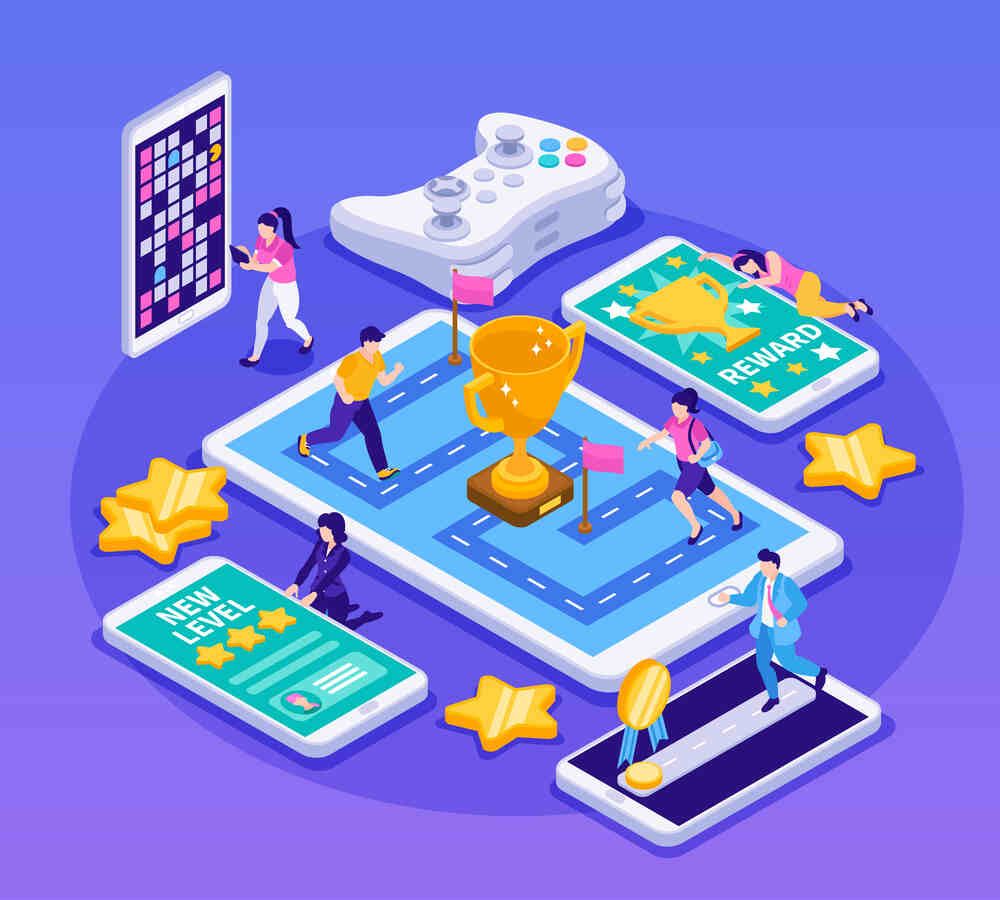
Gamification
Gamification enhances learning experiences by transforming mundane content into interactive activities that drive engagement. Integrating gamification elements like quizzes, challenges, leaderboards and rewards into learning programs can make the process enjoyable and competitive.
Quick tip: Prioritizing user experience in the design of learning programs ensures that content is accessible, intuitive, and inclusive.
Storytelling Techniques
Story-based learning captivates learners by presenting information in a narrative format, making complex concepts more relatable and easier to understand. By weaving real-world scenarios into training content, organizations can create memorable learning journeys. Storytelling adds depth to training programs, fostering emotional connections that enhance knowledge retention.
Interactive Content
Interactive elements like videos, simulations, and virtual reality modules boost learning outcomes by providing hands-on practice and immediate feedback. These tools cater to diverse learning styles and promote active participation.
Incorporating multimedia elements in training content makes the material more engaging and impactful. By offering interactive exercises that require the application of knowledge, organizations can bridge skills gaps effectively.
User-Centric Design
Personalization allows organizations to deliver targeted content based on learners' preferences, roles, and performance levels. Tailoring training programs to address specific training needs increases relevance and effectiveness. Personalized learning paths also empower employees to progress at their own pace.
Learning and Development Process: KPIs
Training Completion Rates
Training completion rates are essential key performance indicators (KPIs) for assessing the effectiveness of learning and development initiatives. By tracking how many employees finish training programs, organizations can gauge engagement levels and identify areas needing improvement.
Employee Feedback Mechanisms
Employee feedback mechanisms play a crucial role in evaluating the impact of L&D programs. Gathering feedback on the relevance, clarity, and usefulness of training sessions helps organizations tailor their programs to better meet the needs of employees. This data is invaluable in ensuring that learning experiences are engaging and impactful.
Skill Acquisition Assessment
Skill acquisition is another vital KPI used to measure the success of learning and development efforts. Assessing whether employees have acquired new skills or improved existing ones provides insight into the effectiveness of training programs. Organizations can use various methods, such as assessments, simulations, or on-the-job performance evaluations, to evaluate skill development.
Find the best talent assessment tools tailored to specific job roles and skills on Unstop.
Data Analytics Tools
By collecting and analyzing data on training outcomes, organizations can gain valuable insights into areas of strength and weakness. This data-driven approach enables organizations to make informed decisions about future training investments and adjustments to existing programs.
Setting Clear Goals
Setting clear and measurable goals helps track progress and the return on investment (ROI) of L&D initiatives. Organizations should establish specific objectives for employee performance improvement, skill development, or knowledge enhancement. These goals serve as benchmarks for measuring success and guiding continuous improvement efforts.
Remember! There are pros and cons of quantifying the results of L&D initiatives. While it helps identify areas for improvement and optimize training strategies, an over-reliance on quantitative data may overlook qualitative aspects of learning experiences.
ROI in Learning and Development
Calculating the return on investment (ROI) of L&D programs involves evaluating both tangible outcomes, like increased productivity and reduced turnover, as well as intangible benefits, such as improved employee satisfaction. This comprehensive approach provides a holistic view of the program's impact.
Measuring Factors for ROI
Assessing the success of learning and development initiatives goes beyond just tracking completion rates. It involves analyzing key performance indicators (KPIs) such as increased productivity, reduced turnover, and enhanced employee satisfaction to determine the true impact on business outcomes:
- Increased productivity directly correlates with improved job performance and efficiency.
- Reduced turnover signifies higher employee engagement and loyalty towards the organization.
- Improved employee satisfaction leads to a positive work environment and higher retention rates.
Benchmarking for Evaluation
Benchmarking and comparative analysis are essential tools in evaluating the effectiveness and efficiency of L&D investments. By comparing internal performance metrics with industry standards or best practices, organizations can identify areas for improvement and innovation within their learning programs.
Conducting regular benchmarking exercises enables companies to stay competitive by staying abreast of current trends and advancements in talent development. It also helps in setting realistic goals for continuous improvement based on industry benchmarks.
Emerging Trends in L&D
AI and Machine Learning
AI and machine learning algorithms offer adaptive learning solutions. These systems analyze learner data to provide customized content, pacing, and assessments, improving engagement and knowledge retention.
Microlearning and Mobile Learning

The rise of microlearning signifies a move towards bite-sized educational content that is easily digestible. Organizations are leveraging new technologies to deliver quick, targeted information, promoting continuous learning and skill development among employees.
Mobile learning solutions further help deliver training materials anytime, anywhere, catering to the modern workforce's dynamic needs.
Soft Skills Development and DEI Initiatives
As organizations recognize the importance of holistic employee growth, there is a growing emphasis on soft skills development. Training programs now focus on nurturing communication, leadership, and teamwork abilities alongside technical competencies.
Furthermore, diversity, equity, and inclusion (DEI) initiatives are shaping the future of learning and development, fostering inclusive environments where all employees feel valued and supported. Companies are integrating DEI principles into their training strategies to create diverse and equitable workplaces.
Closing Thoughts
In today's competitive landscape, investing in learning and development is crucial for the growth of any business. By understanding the nuances between learning and development, crafting effective strategies, and aligning them with business goals, organizations pave the way for success.
Measuring progress through KPIs and focusing on ROI ensures that L&D efforts yield tangible results. Embracing emerging trends in L&D keeps companies ahead of the curve. Remember, continuous learning is not just a choice but a necessity in today's fast-paced world.
Frequently Asked Questions
1. What is the difference between learning and development?
Learning refers to acquiring knowledge or skills, while development involves applying that knowledge for growth. Learning is about gaining information, whereas development focuses on using that information to improve performance and achieve goals.
2. Why is L&D important in career growth?
L&D enhances skills, boosts job performance, and opens up advancement opportunities. By investing in continuous learning, individuals stay relevant in their field, adapt to changes, and increase their market value, leading to a successful and fulfilling career path.
3. How can businesses align L&D with their goals?
By understanding business objectives first, companies can tailor training programs to address specific skill gaps and strategic needs. Aligning L&D initiatives with organizational goals ensures employees are equipped with the right skills to drive success and innovation.
4. How do you measure success in L&D using KPIs?
Key Performance Indicators (KPIs) such as training completion rates, skill proficiency improvements, and employee feedback help gauge the effectiveness of L&D programs. Tracking these metrics allows organizations to assess ROI, identify areas for improvement, and ensure continuous learning impact.
5. What are some emerging trends in Learning and Development?
Personalized learning paths, microlearning modules, virtual reality training, AI-driven insights, and collaborative platforms are some of the emerging trends in L&D. These innovative approaches cater to diverse learning styles, enhance engagement, and create a dynamic learning environment for continuous development.
Explore other similar reads:
- What Is Work Culture? Meaning, Types, And Best Practices
- Difference Between Talent Acquisition And Recruitment: 5 Key Distinctions
- Compensation Management Essentials: Types, Benefits, Process
- Changing Role Of HR: From Administrative To Strategic
- Employee Appreciation Quotes: 110+ Messages Celebrating The Workforce
I’m a reader first and a writer second, constantly diving into the world of content. If I’m not writing or reading, I like watching movies and dreaming of a life by the beach.
Login to continue reading
And access exclusive content, personalized recommendations, and career-boosting opportunities.
Subscribe
to our newsletter
Blogs you need to hog!
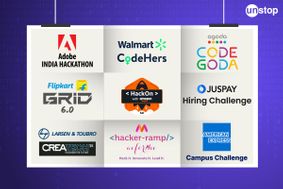
Organize Hackathons: The Ultimate Playbook With Past Case Studies

What is Campus Recruitment? How To Tap The Untapped Talent?
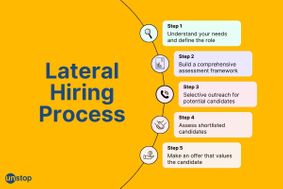
Lateral Hiring: A Complete Guide To The Process, Its Benefits, Challenges & Best Practices
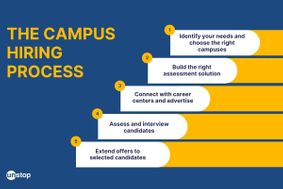












Comments
Add comment